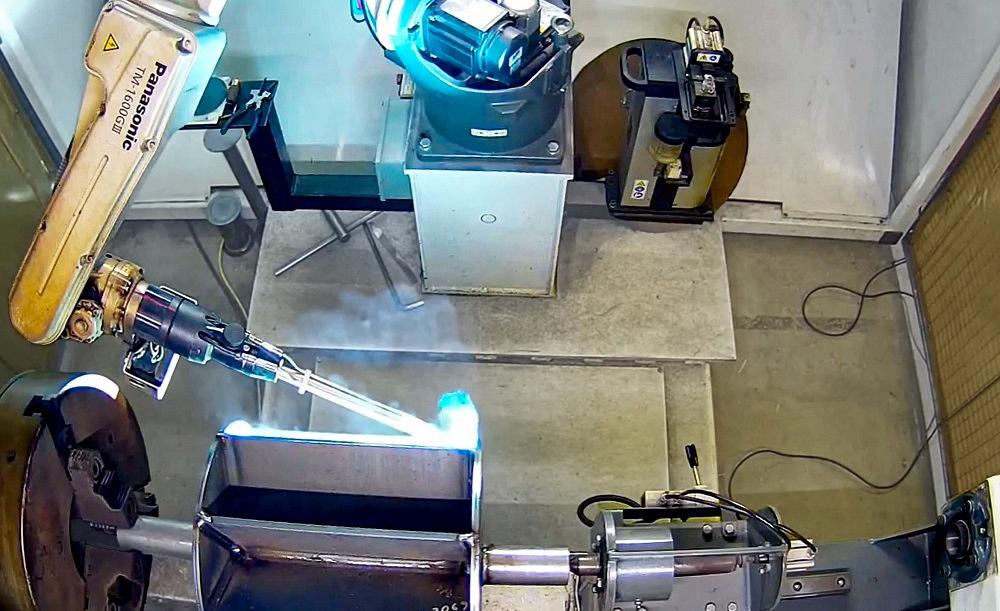- FMA
- The Fabricator
- FABTECH
- Canadian Metalworking
Categories
- Additive Manufacturing
- Aluminum Welding
- Arc Welding
- Assembly and Joining
- Automation and Robotics
- Bending and Forming
- Consumables
- Cutting and Weld Prep
- Electric Vehicles
- En Español
- Finishing
- Hydroforming
- Laser Cutting
- Laser Welding
- Machining
- Manufacturing Software
- Materials Handling
- Metals/Materials
- Oxyfuel Cutting
- Plasma Cutting
- Power Tools
- Punching and Other Holemaking
- Roll Forming
- Safety
- Sawing
- Shearing
- Shop Management
- Testing and Measuring
- Tube and Pipe Fabrication
- Tube and Pipe Production
- Waterjet Cutting
Industry Directory
Webcasts
Podcasts
FAB 40
Advertise
Subscribe
Account Login
Search
Manufacturer increases robotic welding cell productivity with machine vision retrofit
- January 6, 2023
- News Release
- Automation and Robotics
Situation
Schenck Process, a provider of applied measuring and process technology, was having trouble with a robotic welding cell at its Sabetha, Kan., production facility. The main problem was programming. It was time-consuming and tedious, so the company used the cell for only a limited number of parts.
The cell was programmed with a teach pendant. During programming, the operator had to be in the cell, following every robot movement, which meant the cell had to stay idle until programming was completed.
The process for one complex part could take 90 to 120 minutes. For parts like a relief valve with a pipe-in-pipe design, programming for the robotic cell was too complicated, so the valve was welded manually instead.
Resolution
Abagy retrofitted a robotic cell for Schenck Process, installing machine vision and other hardware that is compatible with proprietary software. Setup time for a new product has been reduced to 10 to 15 minutes (a rotor with 18 welds takes about 10 minutes), and the robot can be used for far more products than before—a benefit with Schenck’s high-mix production.
While the robotic cell is used mainly to weld rotors, other product types can be added if necessary. During the first month of the cell’s operation after the retrofit, 50 different technical charts were created. Now, with nearly 100% automatic programming and operation, the relief valve is being produced with robotic welding.
The cell has two working zones. Before the retrofit, it required a separate program for each zone, but now one technical chart created for the product will work for both areas.
Previously, Schenck Process had to measure everything with a ruler when installing each part, as even a small deviation would lead to rework. Now the retrofitted cell tolerates deviations.
Programming now is performed at a desk rather than in the cell, making the process less strenuous for the operator and less prone to error. In addition, the robot can continue to work on a project while the operator sets new tasks for the cell.
subscribe now

The Fabricator is North America's leading magazine for the metal forming and fabricating industry. The magazine delivers the news, technical articles, and case histories that enable fabricators to do their jobs more efficiently. The Fabricator has served the industry since 1970.
start your free subscription- Stay connected from anywhere

Easily access valuable industry resources now with full access to the digital edition of The Fabricator.

Easily access valuable industry resources now with full access to the digital edition of The Welder.

Easily access valuable industry resources now with full access to the digital edition of The Tube and Pipe Journal.
- Podcasting
- Podcast:
- The Fabricator Podcast
- Published:
- 04/16/2024
- Running Time:
- 63:29
In this episode of The Fabricator Podcast, Caleb Chamberlain, co-founder and CEO of OSH Cut, discusses his company’s...
- Trending Articles
AI, machine learning, and the future of metal fabrication

Employee ownership: The best way to ensure engagement

Steel industry reacts to Nucor’s new weekly published HRC price

Dynamic Metal blossoms with each passing year

Metal fabrication management: A guide for new supervisors

- Industry Events
16th Annual Safety Conference
- April 30 - May 1, 2024
- Elgin,
Pipe and Tube Conference
- May 21 - 22, 2024
- Omaha, NE
World-Class Roll Forming Workshop
- June 5 - 6, 2024
- Louisville, KY
Advanced Laser Application Workshop
- June 25 - 27, 2024
- Novi, MI


























